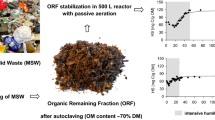Abstract
The change of the degree of stability of compost during the composting process was a kind of guideline for our study. This stability was estimated by monitoring the chemical fractionation (extraction of humic and fulvic acids, and humin) during two cycles of composting. Change of humin (H), humic-like acid carbon (CHA) and fulvic-like acid carbon (CFA) fractions during the composting process of municipal solid wastes were investigated using two windrows W1 (100% of municipal solid wastes) and W2 (60% of municipal solid wastes and 40% of dried sewage sludge). Humin and fulvic acid fractions in the two windrows decreased since the start of composting process and tend to stabilize. At the end of composting process, humic acid fraction is more important in the windrow without sludge (W1) than the one with sludge (W2). The humification indexes used in this study showed that the humic-like acid carbon fraction production takes place largely during the phase of temperature increase (thermophilic phase), and it appeared very active in the windrow W2. At the end of composting process, the E4/E6 ratio value indicated that the compost of W1 is more mature than the compost of W2. The humification ratio (HR) allowed a correct estimation of compost organic matter stabilization level.



Similar content being viewed by others
References
Adani F, Genevini PL, Gasperi F, Zorz G (1997) Organic matter evolution index (OMEI) as a measure of composting efficiency. Compost Sci Util 5:53–62
Bernal MP, Paredes C, Sanchez-Monedero MA, Cegarra J (1998) Maturity and stability parameters of composts prepared with a wide range of organic wastes. Bioresour Technol 63:91–99
Campitelli PA, Velasco MI, Ceppi SB (2003) Charge development and acid-base characteristics of soil and compost humic acids. J Chil Chem Soc 48:91–96
Choppin GR, Allard B (1985) In: Freeman S, Keller B (eds) Handbook on the physics and chemistry of the actinides. Elsevier, Amesterdam, pp 407–429
Garcia C, Hernandez T, Costa F (1991) Changes in carbon fractions during composting and maturation of organic wastes. Environ Manag 15:433–439
Gressel N, McGrath AE, McColl JC, Power RF (1995) Spectroscopy of aqueous extract of forest litter: I. Suitability of methods. Soil Sci Soc Am J 59:1715–1723
Grigatti M, Ciavatta C, Gessa C (2004) Evolution of organic matter from sewage sludge and garden trimming during composting. Bioresour Technol 91:163–169
Hsu JH, Lo SL (1999) Chemical and spectroscopic analysis of organic matter transformations during composting of pig manure. Environ Pollut 104:189–196
Inbar Y, Chen Y, Hadar Y (1990) Humic substances formed during the composting of organic matter. Soil Sci Soc Am J 54:1316–1323
Jimenez EI, Garcia VP (1991) Composting of domestic refuse and sewage sludge. Evolution of temperature, pH, C/N ratio and cation exchange capacity. Resour Conserv Recycl 16:45–60
Jimenez EI, Garcia VP (1992) Determination of maturity indices for city refuse composts. Agric Ecosyst Environ 38:331–343
Leita L, Denobili M (1991) Water soluble fractions of heavy metals during composting of municipal solid waste. J Environ Qual 20:73–78
Mathur SP, Owen G, Dinel H, Schnitzer M (1993) Determination of compost biomaturity. Biol Agric Hortic 10:65–85
Miikki V, Senesi N, Hanninen K (1997) Characterization of humic material formed by composting of domestic and industrial biowastes. 2. Spectroscopic evaluation of humic acid structures. Chemosphere 34:1639–1651
Nelson DW, Sommers LE (1982) Total carbon, organic carbon, and organic matter. In: Page AL et al (eds) Methods of soil analysis. Part 2. Agronmy monographs. American Society of Agronomy, Madison, pp 539–579
Ouatmane A, Provenzano MR, Hafidi M, Senesi N (2000) Compost maturity assessment using calorimetry, spectroscopy and chemical analysis. Compost Sci Util 8:124–134
Piccolo IA (2001) The supramolecular structure of humic substances. Soil Sci 166:810–832
Sanchez-Monedero MA, Roig A, Cegarra J, Bernal MP (1999) Relationships between water-soluble carbohydrate and phenol fractions and the humification indices of different organic wastes during composting. Bioresour Technol 70:193–201
Schnitzer M (1991) Soil organic matter—the next 75 years. Soil Sci 151:41–58
Schnitzer M, Dinel H, Mathur SP, Schulten HR, Owen G (1993) Determination of compost biomaturity. 3. Evaluation of a colorimetric test by C-13-NMR spectroscopy and pyrolysis-field ionization mass-spectrometry. Biol Agric Hortic 10:109–123
Senesi N, Brunetti G (1996) Chemical and physico-chemical parameters for quality evaluation of humic substances during composting. In: Tomati U et al. (eds) Structural changes of humic acids olive oil pomace composting. Compost Sci Util 9:134–142
Stevenson FJ (1986) Cycles of soil: carbon, nitrogen, phosphorus, sulfur, micronutrients. Wiley, New York 380 pp
Stevenson FJ (1994) Humus chemistry: genesis, composition, reactions, 2nd edn. Wiley, New York 512 pp
Sugahara K, Inoko A (1981) Composition analysis of humus and characterization of humic acid obtained from city refuse compost. Soil Sci Plant Nutr 27:213–224
Veeken A, Nierop K, Wilde V, Hamelers B (2000) Characterization of NaOH-extracted humic acids during composting of a biowaste. Bioresour Technol 72:33–41
Wu L, Ma LQ (2002) Relationship between compost stability and extractable organic carbon. J Environ Qual 31:1323–1328
Yagi R, Ferreira ME, Cruz MCP, Barbosa JC (2003) Organic matter fractions and soil fertility under the influence of liming, vermicompost and cattle manure. Sci Agric 60:549–557
Zorpas AA, Dimitris A, Panagiotios K, Maria H, Giovannis Z (2002) Compost quality and use from sewage sludge, organic fraction of municipal solid waste and natural zeolite-clinoptilolite. Recycling of agricultural, municipal and industrial residues in agriculture (RAMIRAN), pp 381–389
Acknowledgments
This study was supported by the Japan International Cooperation Agency (JICA) within the framework of a research program. We thank the staff of a semi-industrial composting plant, Mr K. Ben Khedija and Ms Tounsi N. at ANPE, for their assistance, cooperation and participation in this study.
Author information
Authors and Affiliations
Corresponding author
Rights and permissions
About this article
Cite this article
Fourti, O., Jedidi, N. & Hassen, A. Humic substances change during the co-composting process of municipal solid wastes and sewage sludge. World J Microbiol Biotechnol 26, 2117–2122 (2010). https://doi.org/10.1007/s11274-010-0411-x
Received:
Accepted:
Published:
Issue Date:
DOI: https://doi.org/10.1007/s11274-010-0411-x




